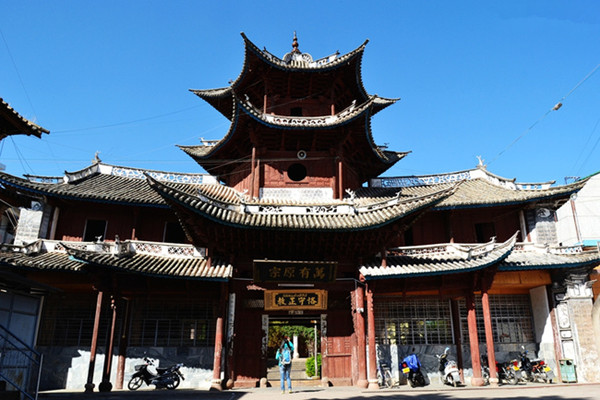Xiaoweigeng Mosque (小围埂清真寺) is located in Xiaoweigeng Village (小围埂村), Yongjian Township (永建乡), Weishan County (巍山县), Yunnan Province (云南省). Originally built in the late Yuan and early Ming dynasties, it serves as the central religious site for the local Hui (回族) Muslim community. The mosque features a blend of Chinese and Arabic architectural styles. Its main prayer hall is a reinforced concrete structure with an Arabic-style domed tower, covering a floor area of 2,300 square meters. The current complex includes a minaret, a teaching building, and other facilities, covering about 15 mu in total. The mosque also houses cultural relics such as the “Sheqi Yongye Tu” (《社契永业图》) stele.
Historically, the mosque served as a base during the Du Wenxiu (杜文秀) anti-Qing uprising and was destroyed by Qing troops in 1873 (the 12th year of the Tongzhi reign). It was rebuilt in 1908 (the 34th year of the Guangxu reign), and the existing structures result from several expansions in the 20th century. Remnants of the uprising—such as parts of the old wall, drill ground, and other relics—still surround the site. Every year on the fifth day of the first lunar month, a Martyrs’ Commemoration Day is held in the village. The mosque’s religious school, Mu Guang School (穆光学校), and influential scholars like Ma Yuncong (马云从) have greatly shaped the development of Islamic education in the area.
In 1997, Xiaoweigeng Mosque (小围埂清真寺) was officially registered as a legal religious venue and is managed by the Ethnic and Religious Affairs Bureau of Weishan County.
Chinese Name: Xiaoweigeng Mosque (巍山县小围埂清真寺)
Location: Xiaoweigeng Village (小围埂村), Yongjian Township (永建乡), Weishan County (巍山县), Yunnan Province (云南省)
Number of Hui Households: 440
Population: Over 2,500 people
Current Imam: Ma Yuncong (马云从)
Current Education Director: Ma Tongbiao (马同标)
Historical Development
Initial Construction
The original prayer hall was built in the late Yuan and early Ming dynasties. In the 12th year of the Tongzhi reign (1873), the mosque was destroyed when Qing forces massacred the village during their campaign against Du Wenxiu (杜文秀).
Reconstruction and Expansion
The mosque was rebuilt in 1908 (34th year of Guangxu), expanded in 1976, and underwent major reconstruction again in 1990.
Architecture and Scale
In 1856 (6th year of the Xianfeng reign), Xiaoweigeng villagers supported Du Wenxiu’s uprising. When Qing troops attacked in 1873, more than 10,000 villagers resisted fiercely, with only around 70 survivors escaping—the rest perished. Today, remnants of city walls, gates, moats, battlements, drill grounds, oath-taking sites, and mass graves still evoke the area’s revolutionary past.
Each year on the fifth day of the first lunar month, villagers recite the Qur’an (《古兰经》) to honor the fallen during the Martyrs’ Commemoration Day. The mosque complex includes the main prayer hall, a central minaret, teaching buildings, and wing rooms. The central minaret divides the mosque into two courtyards.
The prayer hall is a Sino-Arabic hybrid structure built with reinforced concrete, featuring a tiled roof, perforated ridges, crescent and star symbols, and tall domed towers at both front corners. Measuring 37.5 meters in length, 22.5 meters in width, and 18 meters in height, the two-story hall (with basement) has a total area of 2,300 square meters. Its restrained colors and spacious, bright interior make it the second-largest mosque in the county, after the Huicheng Mosque (回辉登清真寺).
The minaret is a square pavilion-style structure with four-pointed corners, containing 12 bays and covering 504 square meters. On the southern side is a four-story reinforced concrete teaching building measuring 24 meters long and 7 meters wide, which houses Mu Guang School (穆光学校). Together with other auxiliary rooms, the total built-up area of the mosque complex reaches 4,610 square meters, occupying about 15 mu.
The mosque houses a stele titled Sheqi Yongye Tu (《社契永业图》), erected in 1914 by villagers, documenting how survivors of the Xianfeng and Tongzhi conflicts reclaimed lost land and rebuilt their village.
Islamic scholar Ma Yuncong (马云从) contributed several works, including Qingzhen Yuzhu (《清真玉柱》), Jiaokuan Juanyao (《教款捐要》), Sipiandao (《四篇要道》), Zifa Chutan (《字法初探》), and Huituibao (《虎退补》).
There are currently 24 Hajjis (哈吉) in the village. With a long-standing tradition of Islamic education, Xiaoweigeng has produced many renowned scholars who continue to influence religious life across Yunnan Province. The respected scholar Ma Ruitu (马瑞图) served as imam from 1941 until his death in 1945 and was buried in Xiaoweigeng. His son Ma Yuncong, also a highly regarded scholar known as “Da Wu Suo” (大吾梭), now serves as the mosque’s imam.
Support from overseas Hui Muslims, such as Haji Huranmao (忽然茂哈吉) from Thailand, has also played a significant role in the mosque’s development and educational initiatives.
Location and Transportation
Xiaoweigeng Mosque (小围埂清真寺) is located in Xiaoweigeng Village (小围埂村), Yongjian Township (永建乡), Weishan County (巍山县), Yunnan Province (云南省).
Additional Information
Xiaoweigeng is one of Yunnan’s most well-known Hui Muslim villages. The name originates from the “weigend” (围埂) walls built during the Mengxizhao (蒙西诏) era. It lies between Qinggeng (青埂) to the east and is traversed by the Guanwei Highway (关巍公路), offering beautiful scenery and convenient transportation. All 440 households—over 2,500 residents—are Hui Muslims who follow the Qadim (格迪目) tradition.

 7 Days GolfingTour
7 Days GolfingTour
 8 Days Group Tour
8 Days Group Tour
 8 Days Yunnan Tour
8 Days Yunnan Tour
 7 Days Shangri La Hiking
7 Days Shangri La Hiking
 11 Days Yunnan Tour
11 Days Yunnan Tour
 6 Days Yuanyang Terraces
6 Days Yuanyang Terraces
 11 Days Yunnan Tour
11 Days Yunnan Tour
 8 Days South Yunnan
8 Days South Yunnan
 7 Days Tea Tour
7 Days Tea Tour
 8 Days Muslim Tour
8 Days Muslim Tour
 12 Days Self-Driving
12 Days Self-Driving
 4 Days Haba Climbing
4 Days Haba Climbing
 Tiger Leaping Gorge
Tiger Leaping Gorge
 Stone Forest
Stone Forest
 Yunnan-Tibet
Yunnan-Tibet
 Hani Rice Terraces
Hani Rice Terraces
 Kunming
Kunming
 Lijiang
Lijiang
 Shangri-la
Shangri-la
 Dali
Dali
 XishuangBanna
XishuangBanna
 Honghe
Honghe
 Kunming
Kunming
 Lijiang
Lijiang
 Shangri-la
Shangri-la
 Yuanyang Rice Terraces
Yuanyang Rice Terraces
 Nujiang
Nujiang
 XishuangBanna
XishuangBanna
 Spring City Golf
Spring City Golf
 Snow Mountain Golf
Snow Mountain Golf
 Stone Mountain Golf
Stone Mountain Golf














